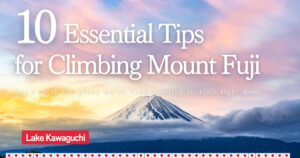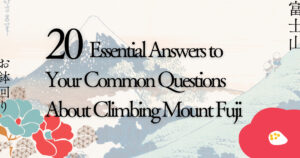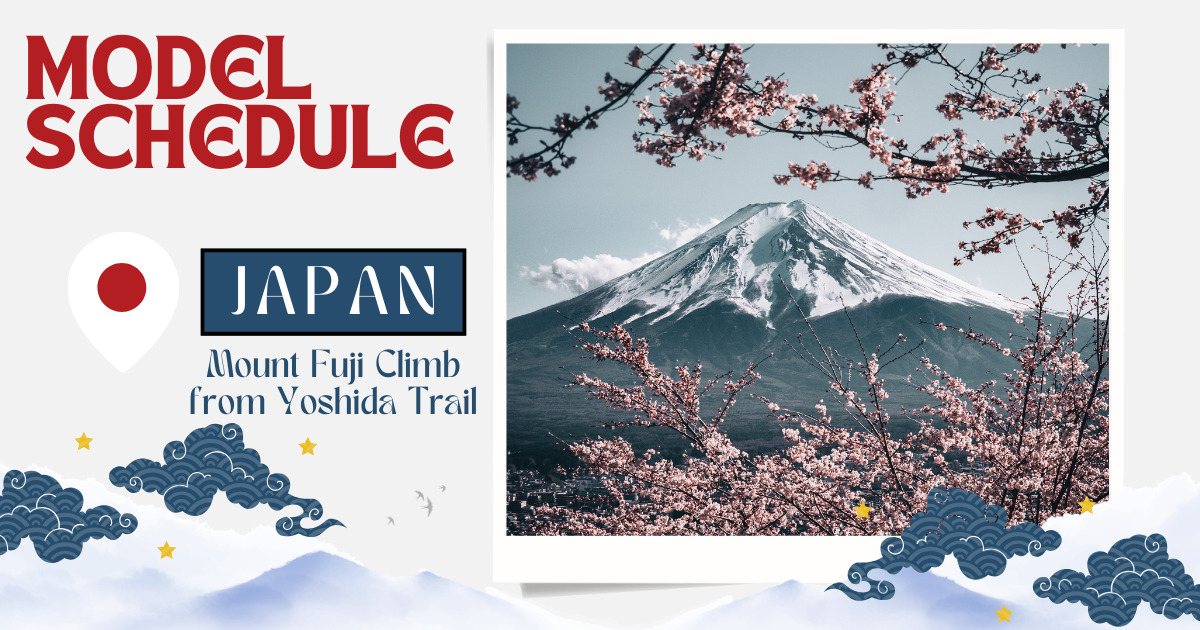Embarking on the iconic journey of climbing Mount Fuji can be a thrilling and transformative experience.
This two-day, one-night adventure will take you through breathtaking landscapes, from the bustling Fifth Station to the serene peak of this sacred mountain.
Whether you’re a first-timer or a returning climber, our comprehensive guide ensures you’re well-prepared for every step of the journey.
Join us as we navigate through the essentials of climbing Mount Fuji, including acclimatization tips, mountain hut etiquette, and the mesmerizing sunrise from Kamaiwakan.
First Day of Climbing Mount Fuji
Arrival at the Fifth Station from Various Locations Before Noon.
10:00 AM – 11:00 AM: Light Meal at the Fifth Station.
From Tokyo, it’s convenient to take an express bus to Mount Fuji and Lake Kawaguchi.
Even at the Fifth Station, which is at an altitude of 2300 meters, take about an hour to acclimate your body to the air pressure while having a light meal and some tea.
To avoid straining your digestive system, remember to chew your food well when eating on the mountain.
11:30 AM: Start Climbing → 1:00 PM: Arrival at Kamaiwa-kan
Kamaiwa-kan
Kamaiwakan-kan is the 4th hut of the Yoshida Trail’s 7th station in Yamanashi Prefecture.
It sit at 2790m (9153ft) above sea level which is perfect for altitude acclimatization.
The climbing time.
It takes 2 hours 30 minutes from 5th station to the hut.
It takes 3 hours 30 minutes from the hut to the summit.
The average climbing time from the Fifth Station to Kamaiwakan is said to be 2 hours and 30 minutes. Maintain a pace slower than on flat ground to avoid getting out of breath.
The altitude of Kamaiwakan is 2790 meters. As it’s located below the altitude where altitude sickness commonly occurs, it’s a suitable place for acclimatization. Enjoy your lunch, rest your tired body in a bed, and acclimate to the air pressure while enjoying the views and sunsets from Mount Fuji.
5:00 PM – 7:00 PM: Dinner
Replenish your energy with a well-chewed meal to ensure a successful summit.
※ Be mindful that alcohol affects you more at high altitudes, so please limit yourself to about one bottle.
Tips for Spending Time in Mountain Huts
Staying in a mountain hut is not about leisurely relaxing in a private room but more about ‘lying down to rest your body’ or ‘sleeping communally.’ There are no baths in any of the huts.
Regardless of gender, tour participants rest together in a large hall or in a space with bunk beds, sometimes with dozens of people. Each person gets about half a bed’s worth of space.
Sleeping arrangements include futons or sleeping bags. During peak seasons, it’s not uncommon for two people to share a single futon set. Even if you can’t sleep, it’s important to remain still and quiet. Conversations should be held outside the sleeping areas, in places like the common room, and in a low voice.
Those who snore loudly are requested to take some measures to minimize the disturbance.
To avoid soiling the bedding, do not sleep in wet clothes from the rain.
After lights out, avoid rustling through your backpack, creating noise and disturbance.
Second Day of Climbing Mount Fuji
Wake up around 4:30 AM.
4:30 AM – 5:25 AM: Sunrise *The time varies depending on the season.
Enjoy the unique daytime climbing experience of panoramic views, sea of clouds, changing scenery, and the variation of plants below.
Enjoy the unique daytime climbing experience of panoramic views, sea of clouds, changing scenery, and the variation of plants below.
The estimated time for the crater rim walk (Ohachimeguri) is about 1 hour and 30 minutes.
Congratulations on a successful ascent and descent!
There are many day-trip hot spring facilities in the town at the base of the mountain, so please take your time to relax and rejuvenate.
A natural hot spring where all spring quality hot spring is blended, which is rare even in the whole country. It is a hot spring that is expected to be effective for skin care.
Hot Spring with a View of Mount Fuji Yurari
Fuji Chobo no Yu Yurari is a hot spring facility that offers guests an opportunity to experience relaxation and rejuvenation. Nestled in a picturesque setting, it provides stunning views of the sacred Mount Fuji, enhancing the therapeutic experience of its natural hot springs. Ideal for those seeking both mental and physical restoration, the facility is a perfect blend of natural beauty and healing comforts, offering a unique and tranquil environment for all visitors.
Congratulations on completing your two-day ascent and descent of Mount Fuji!
This journey is more than just a climb; it’s an unforgettable experience filled with panoramic views, unique flora, and the awe-inspiring beauty of Japan’s most famous mountain.
As you descend back to the Fifth Station, remember to unwind at one of the nearby hot springs, like Fujiyama Onsen or the scenic Fuji Chobo no Yu Yurari, where you can soak in the natural beauty and rejuvenate after your climb.
This adventure is a testament to your endurance and spirit, leaving you with memories and stories to cherish for a lifetime.







